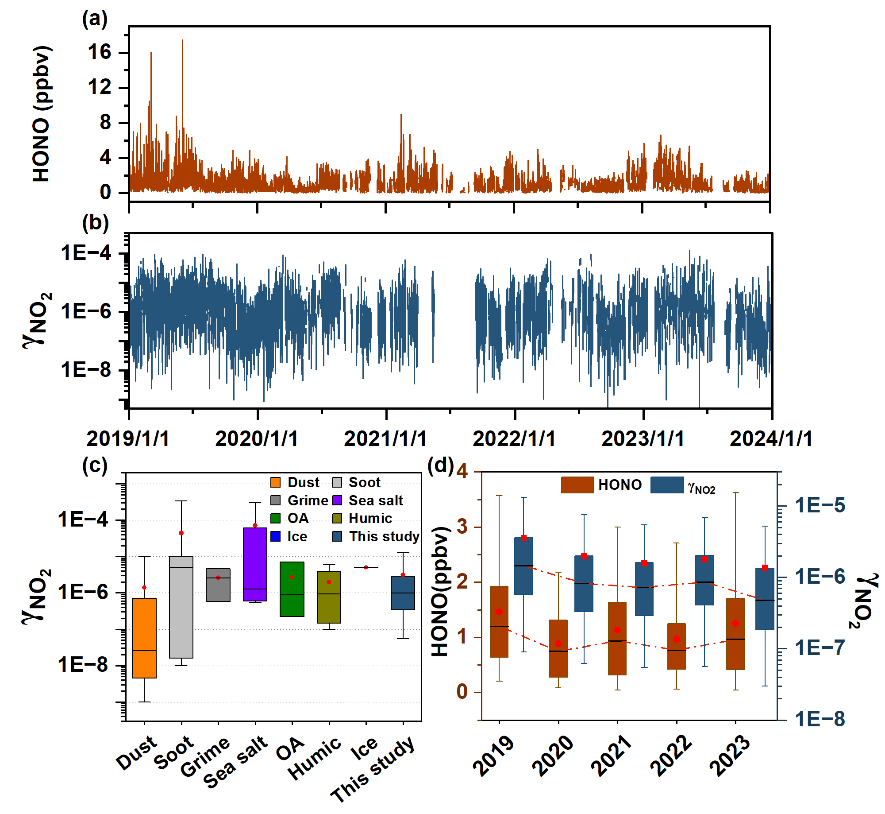Nitrous acid (HONO) is an important precursor of OH radicals in the troposphere, affecting atmospheric oxidation capacity and secondary air pollutant formation. The heterogeneous reaction of NO2 on particulate matter has been considered an important source of HONO in the troposphere, whereas its contribution is controversial due to the lack of uptake coefficient of NO2 (γNO2) on ambient PM2.5. This study conducted long-term continuous field observations and obtained γNO2 on PM2.5 from 2019 to 2023. The driving factors for γNO2 evolution have been investigated using a random forest model combined with Shapley additive explanations.

Figure 1. Long-term variations of HONO concentration and γNO2 in Beijing from January 2019 to January 2024.
The results show that γNO2 on ambient PM2.5 is on the order of 10⁻6, while it has significantly declined from (3.07 ± 5.99) ×10⁻6 in 2019 to (1.43 ± 3.22) ×10⁻6 in 2023. This decline is linked to an increase in aerosol pH, caused by a growing fraction of ammonium nitrate in inorganic salts due to imbalanced desulfurization and denitrification in China. This study indicates that the contribution of NO2 heterogeneous uptake to HONO production is descending in urban environments, offering valuable insights into HONO source apportionment and atmospheric oxidative capacity modeling. Overall, this work challenges a fixed γNO2 value used in atmospheric chemical models and highlights the necessity of accounting for aerosol chemistry evolving. The findings provide essential kinetic data for improving simulations of atmospheric oxidation capacity and offer new insights into secondary pollution formation in megacities.
The work entitled “Changing Aerosol Chemistry is Redefining HONO Sources” was published in Nature Communications. It was collaboratively conducted by researchers from the Beijing University of Chemical Technology, the Institute of Chemistry of the Chinese Academy of Sciences (CAS), the Research Center for Eco-Environmental Sciences of CAS, and the University of Helsinki, Finland. The first author of the paper is Yusheng Zhang, a Ph.D. candidate from the Beijing Advanced Innovation Center for Soft Matter Science and Engineering (BAIC-SM) at Beijing University of Chemical Technology (BUCT). The corresponding authors are Professor Yongchun Liu and Dr. Wei Ma from BAIC-SM, and Professor Weigang Wang from the Institute of Chemistry, CAS. The work was financially supported by the Beijing Natural Science Foundation and the National Natural Science Foundation of China.
Article information: Yusheng Zhang, Yongchun Liu*, Wei Ma*, Chenjie Hua, Feixue Zheng, Chaofan Lian, Weigang Wang*, Men Xia, Zhixin Zhao, Jinwen Li, Jiali Xie, Zongcheng Wang, Yuzheng Wang, Xin Chen, Ying Zhang, Zemin Feng, Chao Yan, Biwu Chu, Wei Du, Veli-Matti Kerminen, Federico Bianchi, Tuukka Petäjä, Douglas Worsnop & Markku Kulmala. Changing aerosol chemistry is redefining HONO sources. Nat Commun., 2025, 16, 5238.
More information can be found at:
https://doi.org/10.1038/s41467-025-60614-7